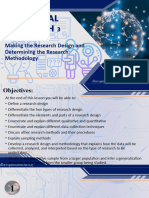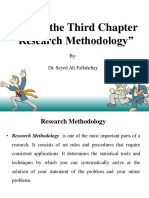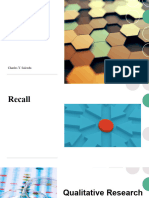0 ratings0% found this document useful (0 votes)
64 viewsLecture No. 2.1 Quantitative Research Design
Lecture No. 2.1 Quantitative Research Design
Uploaded by
Silang MatthewThis document discusses quantitative research designs, including experimental and non-experimental designs. Experimental designs test manipulated variables through randomized controlled trials or quasi-experiments that match or observe groups over time. Non-experimental designs observe naturally occurring variables through surveys, comparisons, correlations or examining past events without manipulation. The document provides examples of specific experimental designs like true experiments, matched comparisons and time series analyses as well as stages of experimental research like formulating hypotheses and collecting data.
Copyright:
© All Rights Reserved
Available Formats
Download as PPTX, PDF, TXT or read online from Scribd
Lecture No. 2.1 Quantitative Research Design
Lecture No. 2.1 Quantitative Research Design
Uploaded by
Silang Matthew0 ratings0% found this document useful (0 votes)
64 views11 pagesThis document discusses quantitative research designs, including experimental and non-experimental designs. Experimental designs test manipulated variables through randomized controlled trials or quasi-experiments that match or observe groups over time. Non-experimental designs observe naturally occurring variables through surveys, comparisons, correlations or examining past events without manipulation. The document provides examples of specific experimental designs like true experiments, matched comparisons and time series analyses as well as stages of experimental research like formulating hypotheses and collecting data.
Copyright
© © All Rights Reserved
Available Formats
PPTX, PDF, TXT or read online from Scribd
Share this document
Did you find this document useful?
Is this content inappropriate?
This document discusses quantitative research designs, including experimental and non-experimental designs. Experimental designs test manipulated variables through randomized controlled trials or quasi-experiments that match or observe groups over time. Non-experimental designs observe naturally occurring variables through surveys, comparisons, correlations or examining past events without manipulation. The document provides examples of specific experimental designs like true experiments, matched comparisons and time series analyses as well as stages of experimental research like formulating hypotheses and collecting data.
Copyright:
© All Rights Reserved
Available Formats
Download as PPTX, PDF, TXT or read online from Scribd
Download as pptx, pdf, or txt
0 ratings0% found this document useful (0 votes)
64 views11 pagesLecture No. 2.1 Quantitative Research Design
Lecture No. 2.1 Quantitative Research Design
Uploaded by
Silang MatthewThis document discusses quantitative research designs, including experimental and non-experimental designs. Experimental designs test manipulated variables through randomized controlled trials or quasi-experiments that match or observe groups over time. Non-experimental designs observe naturally occurring variables through surveys, comparisons, correlations or examining past events without manipulation. The document provides examples of specific experimental designs like true experiments, matched comparisons and time series analyses as well as stages of experimental research like formulating hypotheses and collecting data.
Copyright:
© All Rights Reserved
Available Formats
Download as PPTX, PDF, TXT or read online from Scribd
Download as pptx, pdf, or txt
You are on page 1of 11
Understanding Data and Ways to
Systematically Collect Data
Learning Targets
I can identify the different quantitative research
designs.
I can choose appropriate quantitative research
design.
I can differentiate experimental research design
from non-experimental.
Quantitative Research Designs
Plan or outline of activities
Make aspects of research clearer
Methods, techniques in finding answers and
in collecting data
Types of Quantitative Research Design
Experimental Research Design
bases its research method on a scientific activity
called experiment
Test or examination of manipulated or controlled
variables to determine its validity and truthfulness
Experimental group on which condition, treatment
and intervention is applied
Control group
Experimental Research Design
A. True Experimental Design
Random selection of participants
Bias-free selection that ensures objectivity of results
Best way to examine causal relationship
Experimental Research Design
B. Quasi-Experimental Design
Yield findings that are seemingly or more or less true
Non-adherence to random selection of participants
Prone to bias
Incapable of establishing causal relationship
Quasi-Experimental Research Design
1. Matched comparison group design
Choosing participants for control group which shows
close similarities with the experimental or treatment
group.
2. Time-series quasi-experimental design
Series of pre-test and post-test, multiple observations
before and after the treatment is applied
Quasi-Experimental Research Design
3. Counter-balanced quasi-experimental design
Control is applied to one group to examine the effects
of all treatment and conditions to control variables
4. Single-subject quasi-experimental design
Applying condition or treatment to a single subject like
a class of learners then later find out the effects of the
treatment on the entire class
Experimental Research Design Stages
1. Clear Objectives to follow in conducting the study.
2. Formulate the hypothesis/es
3. Method of testing your hypothesis/es and choosing
appropriate research design
4. Instrumentation in collecting data
5. Sampling procedure
6. Experimentation
7. Collections and analysis of data
Non- Experimental Research Design
Capable of giving quantitative and qualitative data
Often used in the field of social sciences
Shuns controlling variables
Involves variables the way they naturally exist
Types of Non- Experimental Research Design
1. Descriptive – image or picture of an individual or
group
2. Comparative – differences and similarities
3. Correlative – extent and direction of variable
relationship
4. Survey – attitudes, preferences, views, feelings, and
other behavioural patterns
5. Ex Post Facto – explanations about past events
You might also like
- Research Approaches and DesignsDocument3 pagesResearch Approaches and DesignsAnnapurna Dangeti90% (10)
- Go! The Art of ChangeDocument539 pagesGo! The Art of ChangeThe Learning ConnexionNo ratings yet
- Jerome Bruner Acts of MeaningDocument200 pagesJerome Bruner Acts of Meaningalice nie100% (7)
- Chapter 4 WOMEN'S WAYS OF KNOWINGDocument14 pagesChapter 4 WOMEN'S WAYS OF KNOWINGFer Grace AniñonAcabalcuid Cataylo50% (8)
- LEADERSHIP and CommunicationDocument5 pagesLEADERSHIP and CommunicationAdeem Ashrafi100% (4)
- Quantitative Research DesignsDocument3 pagesQuantitative Research Designsvox shawtyNo ratings yet
- Collecting DataDocument21 pagesCollecting DataGlo Anne Ordoño SabadoNo ratings yet
- Quantitative FinalDocument17 pagesQuantitative FinalJoanne Kate GumayagayNo ratings yet
- Research-L11 Quantitative Research DesignDocument21 pagesResearch-L11 Quantitative Research DesignVevienne Canta100% (1)
- Research MethodologyDocument84 pagesResearch MethodologyErica NapigkitNo ratings yet
- Understanding Data and Systematically Collect Data: Presented By: Group 4 HUMSS 12-1Document40 pagesUnderstanding Data and Systematically Collect Data: Presented By: Group 4 HUMSS 12-1Dhex Beltran Cabrales IINo ratings yet
- Research Methods in EducationDocument36 pagesResearch Methods in Educationian92193No ratings yet
- Lesson 1Document2 pagesLesson 1Marky Zhaijan RamosNo ratings yet
- Methods of Collecting DataDocument26 pagesMethods of Collecting DataLolol LololNo ratings yet
- Clinical Psychology Research DesignDocument26 pagesClinical Psychology Research DesignAbdul BasitNo ratings yet
- Clinical Psychology Research DesignDocument26 pagesClinical Psychology Research DesignAbdul BasitNo ratings yet
- Qunatitative ResearchDocument30 pagesQunatitative ResearchJoshua JavierNo ratings yet
- Week 2 Research Design 1Document30 pagesWeek 2 Research Design 1Toryok VibesNo ratings yet
- Nursing ResearchDocument8 pagesNursing ResearchAngelique BarizoNo ratings yet
- Unit 3 Part ADocument90 pagesUnit 3 Part Ap.vishal4973No ratings yet
- Practical Research 2 - Chap.3Document28 pagesPractical Research 2 - Chap.3wendell john medianaNo ratings yet
- 4 The Research DesignDocument74 pages4 The Research DesignKhian PinedaNo ratings yet
- Unit IV Understanding Data and Ways To Systematically Collecting DataDocument19 pagesUnit IV Understanding Data and Ways To Systematically Collecting DataFahad SBNo ratings yet
- Module ResearchDocument16 pagesModule ResearchMARIEL MUTUCNo ratings yet
- ASSIGNMENTRESEARCHDocument11 pagesASSIGNMENTRESEARCHrimsha alishbaNo ratings yet
- Practical Research 2 ReportingDocument64 pagesPractical Research 2 ReportingXeno MontefalcoNo ratings yet
- Understanding Data and Ways To Systematically Collect DataDocument39 pagesUnderstanding Data and Ways To Systematically Collect DataTammyQuiwaHermosa100% (1)
- Appoo6 ReviewerDocument7 pagesAppoo6 ReviewerHoney Joy Leopando SabadoNo ratings yet
- MethodologyDocument58 pagesMethodologyrogianeolinda122No ratings yet
- Lesson 11 and Pr2Document8 pagesLesson 11 and Pr2Jama BustamanteNo ratings yet
- 4 MethodologyDocument20 pages4 MethodologyMatt Alexie Navales MañacapNo ratings yet
- Chapter 3 Research Methodology 2023Document35 pagesChapter 3 Research Methodology 2023Katrina DoblonNo ratings yet
- Research Cot 2Document31 pagesResearch Cot 2Mary DignosNo ratings yet
- Research Reviwer Q4Document9 pagesResearch Reviwer Q4Mia PalomaresNo ratings yet
- Appoo6 ReviewerDocument8 pagesAppoo6 ReviewerHoney Joy Leopando SabadoNo ratings yet
- Research ProcessDocument38 pagesResearch ProcessANTONIO COBALLESNo ratings yet
- Experimental ResearchDocument16 pagesExperimental Researchlijalem gezahagnNo ratings yet
- Chapter 3 - MethodologyDocument14 pagesChapter 3 - MethodologyBryan De Chavez100% (1)
- Research Methods: Unit III Research DesignDocument33 pagesResearch Methods: Unit III Research DesignZanekaNo ratings yet
- Research Methodology ReportDocument17 pagesResearch Methodology ReportJessa Mae GastarNo ratings yet
- Unit 2 Experimental Design PDFDocument15 pagesUnit 2 Experimental Design PDFvarshneypalak0No ratings yet
- Writing The Third Chapter "Research Methodology": By: Dr. Seyed Ali FallahchayDocument28 pagesWriting The Third Chapter "Research Methodology": By: Dr. Seyed Ali FallahchayMr. Copernicus100% (1)
- Lectures Ni SheineDocument42 pagesLectures Ni SheineZedekiah HaloNo ratings yet
- BRM CT 1 AnsDocument6 pagesBRM CT 1 Ansharsh hariharnoNo ratings yet
- Inbound 4589109284561518719Document38 pagesInbound 4589109284561518719Wayne AgudaNo ratings yet
- Asynchronous ActivityDocument2 pagesAsynchronous ActivityKnight VelasquezNo ratings yet
- Research MethodologyDocument11 pagesResearch Methodologyhusali12141618No ratings yet
- Research DesignDocument33 pagesResearch DesignAnji HirufumiNo ratings yet
- Research Methodology: Evalyn C. OlivaDocument84 pagesResearch Methodology: Evalyn C. OlivaJason ManasNo ratings yet
- ResearchDocument12 pagesResearchkhimcabutadporrasNo ratings yet
- Unit-2 BRM Till 8th MayDocument29 pagesUnit-2 BRM Till 8th Mayharsh9097rajNo ratings yet
- Designing A ResearchDocument20 pagesDesigning A ResearchDurga Prasad DashNo ratings yet
- BRM Chap 6 NotesDocument7 pagesBRM Chap 6 NotesShaheryar RashidNo ratings yet
- Business Research: A Way of Thinking A Way of Examining Your PracticeDocument60 pagesBusiness Research: A Way of Thinking A Way of Examining Your PracticeSneha BansalNo ratings yet
- St. Francis Parochial School: Learning Modules For Practical Research 2Document8 pagesSt. Francis Parochial School: Learning Modules For Practical Research 2Nick Lawrence Bermudo LibriaNo ratings yet
- Payal Chhangani (RMPPT)Document27 pagesPayal Chhangani (RMPPT)PayalNo ratings yet
- Lesson 1 Characteristics Strengths Wekanesses Kinds of Quantitative ResearchDocument38 pagesLesson 1 Characteristics Strengths Wekanesses Kinds of Quantitative ResearchmariamariechanNo ratings yet
- MODULE 5. Research MethodologyDocument11 pagesMODULE 5. Research MethodologyRuel ReyesNo ratings yet
- Research Methods in ArchitectureDocument4 pagesResearch Methods in ArchitecturedellcyberNo ratings yet
- Methodology (G12)Document35 pagesMethodology (G12)altheacuaresma13No ratings yet
- Research 2 - Lesson 1Document18 pagesResearch 2 - Lesson 1Christyl MoraledaNo ratings yet
- Chapter Three Research Desings 1Document20 pagesChapter Three Research Desings 1Mimo HemadNo ratings yet
- BRM QuestionsDocument4 pagesBRM QuestionsAyeshaNo ratings yet
- PsychoDocument12 pagesPsychoIsaiasNo ratings yet
- ID NoneDocument12 pagesID NoneF- BoxNo ratings yet
- Expert Learner Strategic Self-Regulated-ReflectiveDocument3 pagesExpert Learner Strategic Self-Regulated-Reflectiveapi-490973801No ratings yet
- Resume Lesson Plan AssignmentDocument5 pagesResume Lesson Plan Assignmentapi-308418238No ratings yet
- Grading Rubric For AssignmentsDocument3 pagesGrading Rubric For AssignmentsNurul Haiyu ShahidahNo ratings yet
- Chapter 1 Introduction To Advanced Business Research Methods 2Document56 pagesChapter 1 Introduction To Advanced Business Research Methods 2Adugna MisganawNo ratings yet
- Review of LiteratureDocument4 pagesReview of LiteratureLINSHA SINGHNo ratings yet
- Trenton Merricks' Epiphenomenalism and Eliminativism: Causality Large and SmallDocument5 pagesTrenton Merricks' Epiphenomenalism and Eliminativism: Causality Large and SmallRobert R. WadholmNo ratings yet
- Williams and Mavin 2012Document21 pagesWilliams and Mavin 2012fionakumaricampbell6631No ratings yet
- Translatology, Translation, Translaton Studies, TraductologyDocument3 pagesTranslatology, Translation, Translaton Studies, TraductologyAnonymous N6GHCjvog1No ratings yet
- The Aristotelian Society and Blackwell Publishing Are Collaborating With JSTOR To Digitize, Preserve andDocument27 pagesThe Aristotelian Society and Blackwell Publishing Are Collaborating With JSTOR To Digitize, Preserve andttyy82122No ratings yet
- Thinking-With-Drawing - Wandering - W Ondering Through Manning's TextDocument21 pagesThinking-With-Drawing - Wandering - W Ondering Through Manning's TextAndré FoglianoNo ratings yet
- Obtaining Linguistic Data - Tu DichDocument3 pagesObtaining Linguistic Data - Tu DichnhtabcdNo ratings yet
- Shaw Agenda-Setting and Mass Communication Theory PDFDocument11 pagesShaw Agenda-Setting and Mass Communication Theory PDFAlberto CastanedaNo ratings yet
- Bilingual Chierdren's Mother TongueDocument6 pagesBilingual Chierdren's Mother TongueDalia AlkhyariNo ratings yet
- Modes of Presentation: 1) Extemporaneous 2) Manuscript 3) Impromptu 4) MemorizationDocument15 pagesModes of Presentation: 1) Extemporaneous 2) Manuscript 3) Impromptu 4) MemorizationShubham Goel100% (1)
- Economics and EthicsDocument2 pagesEconomics and EthicsMicah JakubowiczNo ratings yet
- Mayer, Richards & Barsade - Emerging Research in Emotional Intelligence (Preprint) (OK) PDFDocument44 pagesMayer, Richards & Barsade - Emerging Research in Emotional Intelligence (Preprint) (OK) PDFtitoNo ratings yet
- Remembering Trauma PDFDocument259 pagesRemembering Trauma PDFLena100% (1)
- CLIL PPT Workshop ThuyDuongDocument11 pagesCLIL PPT Workshop ThuyDuongTường CátNo ratings yet
- Reflection and Action: Stage 2Document11 pagesReflection and Action: Stage 2Emily JamesNo ratings yet
- Ananda Marga Gurukula - Issue 35Document32 pagesAnanda Marga Gurukula - Issue 35dadavima100% (1)
- Grounded Theory For ABMDocument24 pagesGrounded Theory For ABMCrizelda RadaNo ratings yet
- Cloud Lesson PlanDocument4 pagesCloud Lesson Planapi-358171560No ratings yet
- The Effects of Physical Attractiveness On Job-Related Outcomes: Meta-Analysis OF Experimental StudiesDocument32 pagesThe Effects of Physical Attractiveness On Job-Related Outcomes: Meta-Analysis OF Experimental StudiesShadowMusic2No ratings yet
- In The Minds of Men Darwin and The New World Order TaylorDocument538 pagesIn The Minds of Men Darwin and The New World Order TaylorPaleoantropologie DinamicaNo ratings yet

























































































